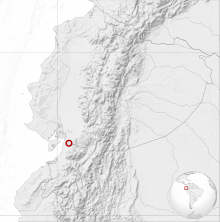
Back Atelopus balios Catalan Atelopus balios CEB Atelopus skvrnitý Czech Atelopus balios Spanish Atelopus balios Basque Atelopus balios French Atelopus balios Italian Atelopus balios Dutch Atelopus balios Portuguese Atelopus balios Swedish
| Atelopus balios | |
|---|---|

| |
| Atelopus balios in Awashima MARINE PARK | |
| Scientific classification | |
| Domain: | Eukaryota |
| Kingdom: | Animalia |
| Phylum: | Chordata |
| Class: | Amphibia |
| Order: | Anura |
| Family: | Bufonidae |
| Genus: | Atelopus |
| Species: | A. balios
|
| Binomial name | |
| Atelopus balios | |

| |
Atelopus balios, the Rio Pescado stubfoot toad, is a species of toad in the family Bufonidae. It is endemic to southwestern Ecuador, with records from Pacific lowlands in Azuay, Cañar, and Guayas Provinces.[1][3] It is a rare species that was already suspected to be extinct,[1] but a single specimen was discovered in 2011 by a team from Conservation International during a hunt for missing amphibians.[4][5][6][7] The decline in amphibian populations is well documented. The Atelopus balios is Critically Endangered as a result of the widespread amphibian Chytridiomycosis fungus that has decimated other amphibian populations.[8] There are only 10 known findings of the tadpole, Atelopus balios.[9]
- ^ a b c IUCN SSC Amphibian Specialist Group (2018). "Atelopus balios". IUCN Red List of Threatened Species. 2018: e.T54491A98640710. doi:10.2305/IUCN.UK.2018-1.RLTS.T54491A98640710.en. Retrieved 14 November 2021.
- ^ Cite error: The named reference
Peters 1973was invoked but never defined (see the help page). - ^ Cite error: The named reference
Frostwas invoked but never defined (see the help page). - ^ Cite error: The named reference
AWEwas invoked but never defined (see the help page). - ^ Cite error: The named reference
novataxawas invoked but never defined (see the help page). - ^ "Ansonia latidisca". Smugmug.com. Retrieved 2011-07-14.
- ^ "Global Search for 'lost' frogs yields few findings, important warnings - Conservation International". Conservation International. Retrieved 2016-04-09.
- ^ "Rio Pascado Stubfoot Toad - Atelopus balios - Details - Encyclopedia of Life". Encyclopedia of Life. Retrieved 2017-10-09.
- ^ “The Tadpole of Atelopus Balios (Anura: Bufonidae) from the Pacific Lowlands of Ecuador.” Herpetologica, vol. 52, no. 1, 1996, pp. 66–70. JSTOR, www.jstor.org/stable/3892957
© MMXXIII Rich X Search. We shall prevail. All rights reserved. Rich X Search
